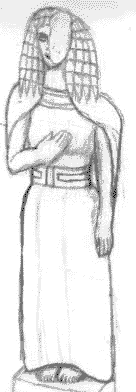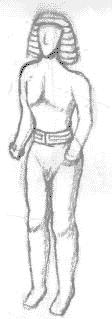| Late Orientalizing Period - first large sculpture - |
The style shown on these figure has been called "Daedalic" named after a half-legendary artist and craftsman. Some ancient writers also used this term, it is, however, uncertain whether they used it in same meaning as ours. Pausanais, an ancient traveler and writer of the second century A.D. reported many Daedalic sculptures include wooden figures. Some of these may older than stone figures, but it is hard to reconstruct the appearance since none has survived. However, it can be imagined that it is not so different from the stone sculptures now we possess. Daedalic style is characterized by the inverted triangular face with flat at the top, round chin, curled forelock and hair in vertical locks, which recall wigs worn by jurors of England. No fold is represented on the dress, which is fastened by a belt. Both standing and seated figure are in strict frontal view. This style is also applied not only for relief or smaller sculpture of bronze (Delphi 2527:Fig.2) and ivory and clay, but also for the figured-heads attached to pottery. These large figures were inspired by the contact with East, especially with Egypt, where over life-sized sculpture was manufactured. Greek artists who visited there and saw them introduced it in their art, but represented in Greek tradition. A relief sculpture of Daedalic style was excavated from the temple of Apollo in Gortyn (Herakleion379). A man striding between two naked women holds their hair by his hand to support his weight. Two seated women figures and some reliefs were found from Prinias. These figures has been reconstructed in Heraklion Museum but the restoration is problematic. The style of the women is close to that of Auxerre Goddess, but they wear polos, tall hat or clown, and the feature is represented in more realistically. The fact that these figures were only found from Crete is interesting if compared with that the artist Daedalos was worked in Crete after expelled from Athens. Some bronze figurines were manufactured in Daedalic style but there are also many statuettes in old tradition. The typical example is the warrior from Olympia (Olympia B1701), wearing a tall hat and a loin-cloth already seen in the first half of seventh century B.C. Bibliography
|

